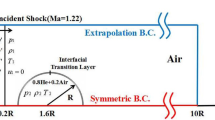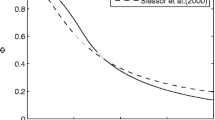Abstract
Effects of Reynolds (Re) number and Schmidt (Sc) number on the flow structures and variable density mixing are numerically investigated through the canonical shock cylindrical bubble interaction. By determining the viscosity and diffusivity within a wide range, the controlling parameters, total vortex circulation, and compression rate, are conservative under a broad range of Re and Sc numbers (Re ≈ 103–105 and Sc ≈ 0.1–5) in the same shock Mach (Ma) number condition (Ma = 2.4). As for the Re number effect, the circulation of secondary baroclinic vorticity (SBV), induced by the main vortex centripetal acceleration, is observed to be higher in high Re number and vice versa. Based on the vorticity transport equation decomposition, a growth-inhibition vorticity dynamics balance mechanism is revealed: the vorticity viscous term grows synchronously with baroclinic production to inhibit SBV production in low Re number. By contrast, the viscous term terminates the baroclinic term with a time lag in high Re number, leading to the SBV production. Since the SBV reflects the local stretching enhancement based on the advection-diffusion equation, mixing is influenced by the Sc number in a different behavior if different Re numbers are considered. The time-averaged variable density mixing rate emerges a scaling law with Sc number as \(\overline {\left\langle {{\chi ^ *}} \right\rangle} = \beta \cdot S{c^{- \alpha}}\), where the coefficient β ∼ Re−0.2 and the scaling exponent α ∼ Re−0.385. The understanding of Re number and Sc number effect on variable density mixing provides an opportunity for mixing enhancement from the perspective of designing the viscosity and diffusivity of the fluid mixture.

摘要
惯性约束聚变、 水动力空化侵蚀和微观尺度激波加速流动中的激波-气泡相互作用(SBI) 构型处于高粘度(低雷诺数)或低扩散率(高施密特数)环境中, 其混合性能尚不清楚. 通过测定宽范围内的粘度和扩散系数, 采用高分辨率数值模拟研究了雷诺数Re和施密特数Sc对SBI流动结构和混合行为的影响. 次级斜压涡度(SBV)增长明显受雷诺数的影响, 表现为斜压涡和粘性耗散之间的生长抑制涡度动力学**衡. 混合速率受施密特数的影响, 标度为\(\overline {\left\langle {{\chi ^ *}} \right\rangle} = \beta \cdot S{c^{- \alpha}}\), 其中系数β ∼ Re−0.2 和标度指数α ∼ Re−0.385. 混合标度表明, 较高雷诺数下的SBV拉伸增**导致混合速率对施密特数的依赖性减弱, 这可能为实际应用中的混合增**设计开辟新的途径.
Similar content being viewed by others
References
D. Ranjan, J. Oakley, and R. Bonazza, Shock-bubble interactions, Annu. Rev. Fluid Mech. 43, 117 (2011).
Y. Zhou, Rayleigh-Taylor and Richtmyer-Meshkov instability induced flow, turbulence, and mixing-II, Phys. Rep. 723–725, 1 (2017).
J. D. Lindl, R. L. McCrory, and E. M. Campbell, Progress toward ignition and burn propagation in inertial confinement fusion, Phys. Today 45, 32 (1992).
B. Tian, D. Fu, and Y. Ma, Numerical investigation of Richtmyer-Meshkov instability driven by cylindrical shocks, Acta Mech. Sin. 22, 9 (2006).
Z. Zhou, J. Ding, Z. Zhai, W. Cheng, and X. Luo, Mode coupling in converging Richtmyer-Meshkov instability of dual-mode interface, Acta Mech. Sin. 36, 356 (2020).
M. Gui, B. Fan, G. Dong, and J. Ye, Experimental and numerical studies on interactions of a spherical flame with incident and reflected shocks, Acta Mech. Sin. 25, 173 (2009).
Y. J. Zhu, G. Dong, Y. X. Liu, B. C. Fan, and H. Jiang, Effect of chemical reactivity on the detonation initiation in shock accelerated flow in a confined space, Acta Mech. Sin. 29, 54 (2013).
H. Jiang, G. Dong, X. chen, and J. T. Wu, Numerical simulations of the process of multiple shock-flame interactions, Acta Mech. Sin. 32, 659 (2016).
J. Yang, T. Kubota, and E. E. Zukoski, A model for characterization of a vortex pair formed by shock passage over a light-gas inhomogeneity, J. Fluid Mech. 258, 217 (1994).
B. Yu, M. He, B. Zhang, and H. Liu, Two-stage growth mode for lift-off mechanism in oblique shock-wave/jet interaction, Phys. Fluids 32, 116105 (2020), ar**v: 2007.05713.
B. Zhang, H. Liu, B. Yu, Z. Wang, M. He, and H. Liu, Numerical investigation on combustion-enhancement strategy in shock-fuel jet interaction, AIAA J. 60, 1 (2021).
R. I. Klein, C. F. McKee, and P. Colella, On the hydrodynamic interaction of shock waves with interstellar clouds-1: Nonradiative shocks in small clouds, Astrophys. J. 420, 213 (1994).
Z. Zhai, T. Si, X. Luo, and J. Yang, On the evolution of spherical gas interfaces accelerated by a planar shock wave, Phys. Fluids 23, 084104 (2011).
Z. G. Zhai, T. Si, L. Y. Zou, and X. S. Luo, Jet formation in shock-heavy gas bubble interaction, Acta Mech. Sin. 29, 24 (2013).
Z. Zhai, M. Wang, T. Si, and X. Luo, On the interaction of a planar shock with a light polygonal interface, J. Fluid Mech. 757, 800 (2014).
G. Rudinger, and L. M. Somers, Behaviour of small regions of different gases carried in accelerated gas flows, J. Fluid Mech. 7, 161 (1960).
G. I. Taylor, Formation of a vortex ring by giving an impulse to a circular disk and then dissolving it away, J. Appl. Phys. 24, 104 (1953).
J. M. Picone, and J. P. Boris, Vorticity generation by shock propagation through bubbles in a gas, J. Fluid Mech. 189, 23 (1988).
R. Samtaney, and N. J. Zabusky, Circulation deposition on shock-accelerated planar and curved density-stratified interfaces: models and scaling laws, J. Fluid Mech. 269, 45 (1994).
J. H. J. Niederhaus, J. A. Greenough, J. G. Oakley, D. Ranjan, M. H. Anderson, and R. Bonazza, A computational parameter study for the three-dimensional shock-bubble interaction, J. Fluid Mech. 594, 85 (2008).
J. S. Bai, L. Y. Zou, T. Wang, K. Liu, W. B. Huang, J. H. Liu, P. Li, D. W. Tan, and C. L. Liu, Experimental and numerical study of shock-accelerated elliptic heavy gas cylinders, Phys. Rev. E 82, 056318 (2010).
D. Li, G. Wang, and B. Guan, On the circulation prediction of shock-accelerated elliptical heavy gas cylinders, Phys. Fluids 31, 056104 (2019).
W. G. Zeng, J. H. Pan, Y. X. Ren, and Y. T. Sun, Numerical study on the turbulent mixing of planar shock-accelerated triangular heavy gases interface, Acta Mech. Sin. 34, 855 (2018).
G. Peng, N. J. Zabusky, and S. Zhang, Vortex-accelerated secondary baroclinic vorticity deposition and late-intermediate time dynamics of a two-dimensional Richtmyer-Meshkov interface, Phys. Fluids 15, 3730 (2003).
N. Peng, Y. Yang, J. Wu, and Z. **ao, Mechanism and modelling of the secondary baroclinic vorticity in the Richtmyer-Meshkov instability, J. Fluid Mech. 911, A56 (2021).
N. Peng, Y. Yang, and Z. **ao, Effects of the secondary baroclinic vorticity on the energy cascade in the Richtmyer-Meshkov instability, J. Fluid Mech. 925, A39 (2021).
J. W. Jacobs, Shock-induced mixing of a light-gas cylinder, J. Fluid Mech. 234, 629 (1992).
J. Ou, and Z. Zhai, Effects of aspect ratio on shock-cylinder interaction, Acta Mech. Sin. 35, 61 (2019).
S. Kumar, G. Orlicz, C. Tomkins, C. Goodenough, K. Prestridge, P. Vorobieff, and R. Benjamin, Stretching of material lines in shock-accelerated gaseous flows, Phys. Fluids 17, 082107 (2005).
K. A. Buch, and W. J. A. Dahm, Experimental study of the fine-scale structure of conserved scalar mixing in turbulent shear flows-Part 1-Sc > 1, J. Fluid Mech. 317, 21 (1996).
C. Tomkins, S. Kumar, G. Orlicz, and K. Prestridge, An experimental investigation of mixing mechanisms in shock-accelerated flow, J. Fluid Mech. 611, 131 (2008).
D. Li, B. Guan, and G. Wang, Numerical study on shock-accelerated heavy gas cylinders with diffusive interfaces, Acta Mech. Sin. 35, 750 (2019).
B. M. Cetegen, and N. Mohamad, Experiments on liquid mixing and reaction in a vortex, J. Fluid Mech. 249, 391 (1993).
J. Yang, Z. H. Wan, B. F. Wang, and D. J. Sun, Numerical simulation of shock bubble interaction with different mach numbers, Chin. Phys. Lett. 32, 034701 (2015).
B. Yu, H. Liu, and H. Liu, Scaling behavior of density gradient accelerated mixing rate in shock bubble interaction, Phys. Rev. Fluids 6, 064502 (2021), ar**v: 2007.05712.
Y. Li, Z. Wang, B. Yu, B. Zhang, and H. Liu, Gaussian models for late-time evolution of two-dimensional shock-light cylindrical bubble interaction, Shock Waves 30, 169 (2020).
J. Giordano, and Y. Burtschell, Richtmyer-Meshkov instability induced by shock-bubble interaction: Numerical and analytical studies with experimental validation, Phys. Fluids 18, 036102 (2006).
M. L. Wong, D. Livescu, and S. K. Lele, High-resolution Navier-Stokes simulations of Richtmyer-Meshkov instability with reshock, Phys. Rev. Fluids 4, 104609 (2019).
A. W. Cook, and P. E. Dimotakis, Transition stages of Rayleigh-Taylor instability between miscible fluids, J. Fluid Mech. 443, 69 (2001).
Z. X. Hu, Y. S. Zhang, B. Tian, Z. He, and L. Li, Effect of viscosity on two-dimensional single-mode Rayleigh-Taylor instability during and after the reacceleration stage, Phys. Fluids 31, 104108 (2019).
N. Saleki-Haselghoubi, and A. Dadvand, Simulation of bubble dynamics oscillating near a circular aperture made in a curved rigid plate using boundary element method, Ocean Eng. 151, 12 (2018).
S. Huang, W. Wang, and X. Luo, Molecular-dynamics simulation of Richtmyer-Meshkov instability on a Li-H2 interface at extreme compressing conditions, Phys. Plasmas 25, 062705 (2018).
Z. Wu, S. Huang, J. Ding, W. Wang, and X. Luo, Molecular dynamics simulation of cylindrical Richtmyer-Meshkov instability, Sci. China-Phys. Mech. Astron. 61, 114712 (2018).
B. Zhang, H. Chen, B. Yu, M. He, and H. Liu, Molecular simulation on viscous effects for microscale combustion in reactive shock-bubble interaction, Combust. Flame 208, 351 (2019).
H. C. Liu, B. Yu, H. Chen, B. Zhang, H. Xu, and H. Liu, Contribution of viscosity to the circulation deposition in the Richtmyer-Meshkov instability, J. Fluid Mech. 895, A10 (2020).
B. Walchli, and B. Thornber, Reynolds number effects on the single-mode Richtmyer-Meshkov instability, Phys. Rev. E 95, 013104 (2017).
Z. Wang, B. Yu, H. Chen, B. Zhang, and H. Liu, Scaling vortex break-down mechanism based on viscous effect in shock cylindrical bubble interaction, Phys. Fluids 30, 126103 (2018).
B. M. Cetegen, and J. P. Aguirre, Analysis of molecular mixing and chemical reaction in a vortex pair, Phys. Fluids A-Fluid Dyn. 2, 2211 (1990).
P. L. Miller, and P. E. Dimotakis, Reynolds number dependence of scalar fluctuations in a high Schmidt number turbulent jet, Phys. Fluids A-Fluid Dyn. 3, 1156 (1991).
A. Bagabir, and D. Drikakis, Mach number effects on shock-bubble interaction, Shock Waves 11, 209 (2001).
G. Liang, B. Yu, B. Zhang, H. Xu, and H. Liu, Hidden flow structures in compressible mixing layer and a quantitative analysis of entrainment based on Lagrangian method, J. Hydrodyn 31, 256 (2019).
C. Liu, Z. Wang, B. Yu, B. Zhang, and H. Liu, Optimal excitation mechanism for combustion enhancement of supersonic shear layers with pulsed jets, Int. J. Hydrogen Energy 45, 23674 (2020).
A. Glezer, The formation of vortex rings, Phys. Fluids 31, 3532 (1988).
P. Meunier, and E. Villermaux, How vortices mix, J. Fluid Mech. 476, 213 (2003).
A. M. Abd-El-Fattah, and L. F. Henderson, Shock waves at a slow-fast gas interface, J. Fluid Mech. 89, 79 (1978).
S. Gupta, S. Zhang, and N. J. Zabusky, Shock interaction with a heavy gas cylinder: Emergence of vortex bilayers and vortex-accelerated baroclinic circulation generation, Laser Part. Beams 21, 443 (2003).
M. C. Soteriou, and A. F. Ghoniem, Effects of the free-stream density ratio on free and forced spatially develo** shear layers, Phys. Fluids 7, 2036 (1995).
D. K. Lee, G. Peng, and N. J. Zabusky, Circulation rate of change: A vortex approach for understanding accelerated inhomogeneous flows through intermediate times, Phys. Fluids 18, 097102 (2006).
Y. Bouremel, M. Yianneskis, and A. Ducci, On the utilisation of vorticity and strain dynamics for improved analysis of stirred processes, Chem. Eng. Res. Des. 87, 377 (2009).
H. Liu, B. Yu, B. Zhang, and Y. **ang, On mixing enhancement by secondary baroclinic vorticity in a shock-bubble interaction, J. Fluid Mech. 931, A17 (2022).
P. E. Dimotakis, Turbulent mixing, Annu. Rev. Fluid Mech. 37, 329 (2005).
Author information
Authors and Affiliations
Corresponding authors
Additional information
This work was supported by the National Natural Science Foundation of China (NSFC) (Grant No. 91941301), and the Key Research and Development Project of Sichuan Province (Grant No. 2019ZYZF0002). Besides, the authors would acknowledge the Center for High-Performance Computing of Shanghai Jiao Tong University to provide the supercomputer π 2.0. Finally, the anonymous referees are gratefully acknowledged for their valuable comments.
Rights and permissions
About this article
Cite this article
Yu, B., Li, L., Xu, H. et al. Effects of Reynolds number and Schmidt number on variable density mixing in shock bubble interaction. Acta Mech. Sin. 38, 121256 (2022). https://doi.org/10.1007/s10409-022-09011-9
Received:
Accepted:
Published:
DOI: https://doi.org/10.1007/s10409-022-09011-9




